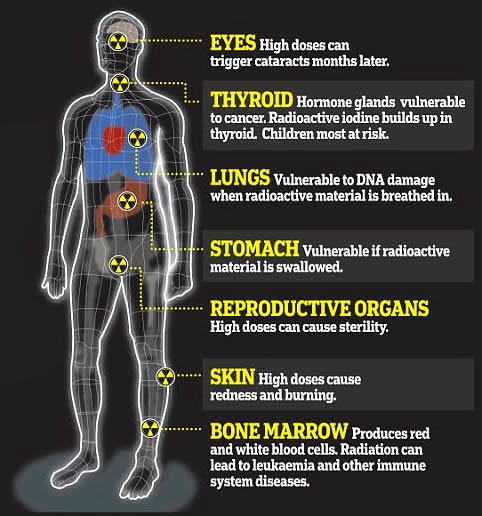 |
| Radioactive Fallout |
The term radioactive fallout, or just fallout, refers to the debris and radioactive materials that settle out of the air after the detonation of a nuclear weapon or after a nuclear accident that produces a cloud of airborne material, or plume.
Detonation of a nuclear weapon results in the immediate propagation of a shock wave and intense heat. As the superheated fireball rises, a vacuum is formed that draws in scorched building material, soil, and other materials from the epicenter of the blast.
In addition, radionuclides produced in the nuclear chain reaction leading to the explosion and any weapon material not consumed in that reaction will also be a part of the subsequent plume. Any similar thermal process, such as the intense fire during the Chernobyl I reactor accident in 1986, will introduce radioactive and other materials into the atmosphere, as well.
  |
The direction and distance the fallout travels depends largely on weather conditions. Wind speed, wind direction, atmospheric stability, and the amount of rain all factor into the extent and timing of the fallout and subsequent contamination.
The amount of radioactive contamination depends on the initial amount of radioactive material contained, for instance, in a nuclear weapon. In the case of a reactor fire or steam explosion, the damage to the reactor, the amount of material at risk, and the length of time until the event is under control are all factors.
 |
| Radiation effect on health |
Exposure to radioactive materials, either while still in the plume, or after the fact as contamination, is the basis for potential health concerns. While alpha-emitting fallout material is not the external hazard that beta-, gamma- and x-ray-emitting materials can be, all of these materials are a potential internal hazard concern when the contamination spreads to sources of groundwater and surface water, livestock, crops, and other foodstuffs.
Fallout effects can be long lasting, contaminating an area for hundreds or even thousands of years. Fallout also enters the food chain. Cows eating contaminated grass produce contaminated milk, which can pose a widespread health risk.
As with anything to do with radiation, it is the amount of absorbed energy, or the radiation absorbed dose, that matters. Remaining indoors, with doors and windows shut and air conditioning systems turned off until the plume has passed, can reduce exposure to fallout.
   |
Traveling out of the path of an incoming plume, if this can be predicted accurately, may also help avoid or reduce exposure to the fallout. Certain foodstuffs, especially water and milk, may have to be brought in from unaffected areas.
Time will be one of the best countermeasures should such an event occur. The “seven–ten” rule for nuclear detonations states that for every seven-fold increase in time after a weapon detonation, there will be a concomitant tenfold decrease in the amount of dose afforded by the fallout.